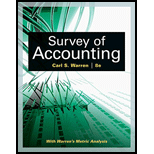
Concept explainers
Concept Introduction:
Decision making plays an important role in the management. The decisions taken by managers are called managerial decisions. Managerial Decisions are decisions taken by managers for the operations of a firm. These decisions include setting target growth rates, hiring or firing employees, and deciding what products to sell. Manager's decisions are taken on the basis of quantitative as well as the qualitative measures. The managerial decision includes the decisions like make or buy, accept or reject new offers, sell or further process etc. These decisions are taken on the basis of relevant costs.
Relevant costs are the costs that are relevant for any decision making. Relevant costs are helpful for take managerial decisions like make or buy, accept or reject new offers, sell or further process etc.
Two basic types of the relevant costs are as follows:
- Out-of-pocket costs
- Opportunity costs
To Indicate:
Three qualitative factors to be considered for the investment decision
Want to see the full answer?
Check out a sample textbook solution
Chapter 15 Solutions
Survey of Accounting (Accounting I)
- I am trying to find the accurate solution to this general accounting problem with the correct explanation.arrow_forward← Week 1: Homework Question 3 of 4 8.75/10 The project is completed in 2025, and a successful patent is obtained. The R&D costs to complete the project are $113,000. The administrative and legal expenses incurred in obtaining patent number 472-1001-84 in 2025 total $16,000. The patent has an expected useful life of 5 years. Record the costs for 2025 in journal entry form. Also, record patent amortization (full year) in 2025. (Credit account titles are automatically indented when amount is entered. Do not indent manually. If no entry is required, select "No Entry" for the account titles and enter O for the amounts. List all debit entries before credit entries.) Account Titles and Explanation Research and Development Expense Cash (To record research and development costs) Patents Cash (To record legal and administrative costs) Amortization Expense Patents (To record one year's amortization expense) Debit 113000 16000 3200 Credit 113000 16000 3200arrow_forwardJoe transfers land to JH Corporation for 90% of the stock in JH Corporation worth $20,000 plus a note payable to Joe in the amount of $40,000 and the assumption by JH Corporation of a mortgage on the land in the amount of $100,000. The land, which has a basis to Joe of $70,000, is worth $160,000. a. Joe will have a recognized gain on the transfer of $90,000. b. Joe will have a recognized gain on the transfer of $30,000.c. JH Corporation will have a basis in the land transferred by Joe of $70,000. d. JH Corporation will have a basis in the land transferred by Joe of $160,000. e. None of the above.arrow_forward
- Please provide the correct answer to this general accounting problem using accurate calculations.arrow_forwardCan you solve this general accounting question with accurate accounting calculations?arrow_forwardCan you help me solve this general accounting question using valid accounting techniques?arrow_forward
 Managerial Accounting: The Cornerstone of Busines...AccountingISBN:9781337115773Author:Maryanne M. Mowen, Don R. Hansen, Dan L. HeitgerPublisher:Cengage Learning
Managerial Accounting: The Cornerstone of Busines...AccountingISBN:9781337115773Author:Maryanne M. Mowen, Don R. Hansen, Dan L. HeitgerPublisher:Cengage Learning Cornerstones of Cost Management (Cornerstones Ser...AccountingISBN:9781305970663Author:Don R. Hansen, Maryanne M. MowenPublisher:Cengage LearningPrinciples of Accounting Volume 2AccountingISBN:9781947172609Author:OpenStaxPublisher:OpenStax College
Cornerstones of Cost Management (Cornerstones Ser...AccountingISBN:9781305970663Author:Don R. Hansen, Maryanne M. MowenPublisher:Cengage LearningPrinciples of Accounting Volume 2AccountingISBN:9781947172609Author:OpenStaxPublisher:OpenStax College


